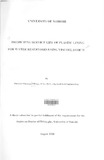| dc.description.abstract | The use ol High Density Polyethylene (HDPE) lining in seepage prevention in small ponds had previously been identified as having potential to drastically reduce the cost of water storage. However, in order to be able to make it acceptable to end users, it is necessary to determine its lifespan when exposed to tropical climates with high day and low night temperatures as well as other degrading agents. The main objective of this research study was therefore to determine the service life of IIDPE lining when exposed to natural degradation in tropical climates using viscoelastic models. The basic material properties were determined for fresh and naturally degraded specimens exposed to natural degradation for three, four and seven years. The tensile strength, density and maximum strain ranged from 12 MPa, 1290 kg/m3 and 3.5 mm/mm respectively for fresh specimens to 25 MPa, 1070 kg/nv and 1.3 mm/mm respectively for specimens degraded naturally for 7 years. A test rig for determination of tensile creep was developed for use in an oven to allow readings to be taken without opening the oven in the course of experimentation. Accelerated techniques of predicting the long term properties of the material were identified. In particular, incubation of specimens in Igepal® and exposure to low wavelength light (254nm) to simulate the effect of hydrolytic degradation and photo-degradation respectively was analysed. The Findley Power Law was used to build a model for prediction of the material behaviour at elevated temperature in both short term and long term applications. Time-Temperature Superposition (T I SP) was also used to develop master curves for prediction of long term properties at a reference temperature of 30°C. Micrographs were also presented to track the changes that took place in the
ii
material during the aging process under different conditions. Naturally degraded specimens were collected from the field and tested in tensile creep. From the results, a simple model was developed on the basis of specimens collected from the field that had a well documented history. This model allows for estimation of the service life of the HDPE lining, and only requires the determination of maximum strain at a given temperature. From this model, being an exponential decay equation, it was also concluded that the degradation of the material lakes place in the first few months of installation and any shading needs to be done in the initial stages otherwise, it may not be viable in the latter stages of use after exposure to the degradation agents. It was further concluded that the welded joint was the most serious factor undermining the service life ol the lining material under tensile creep and that welding of this particular material needs to be carried out above I76°C for hot air welding and at a knife temperature of 400°C for knife welding at a pressure of 0.3 MPa for a dwell time of 10s, for the weld to achieve the highest level of bonding. It was also concluded that alternating temperature had a more damaging el feet on the lining material than elevated temperature in the same range and this showed that the lining is likely to suffer more damage in the tropics than in other climates. | en_US |



